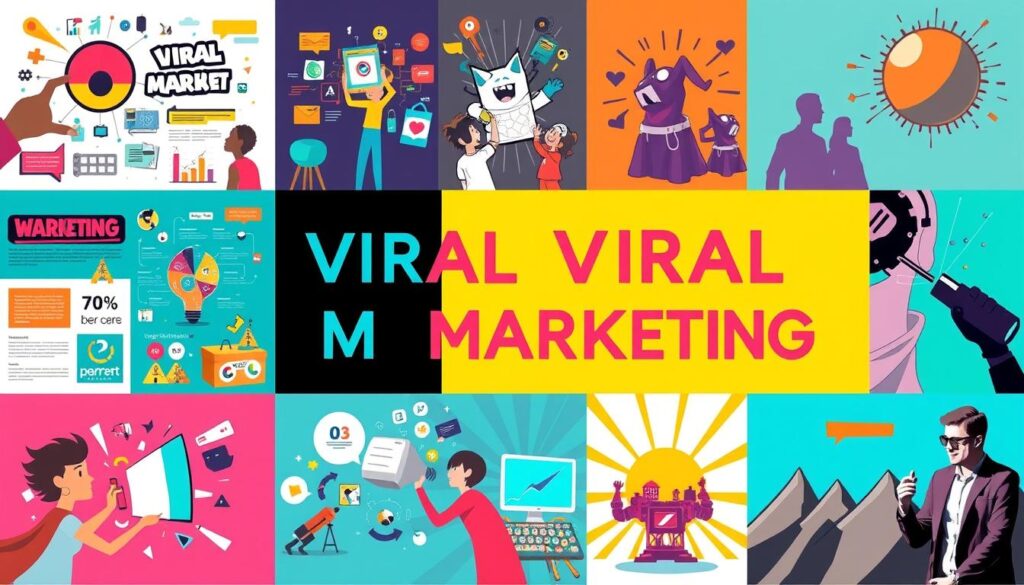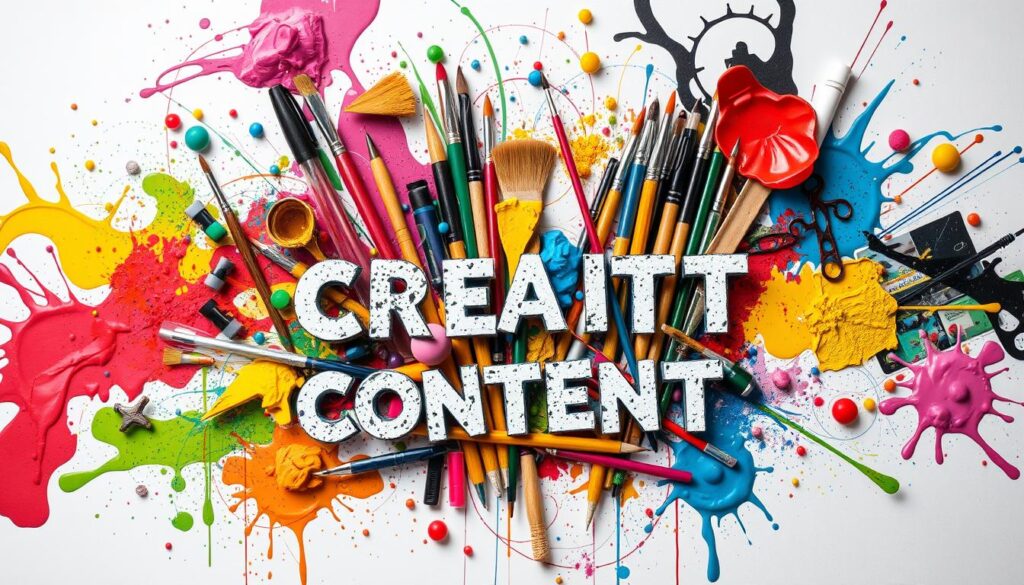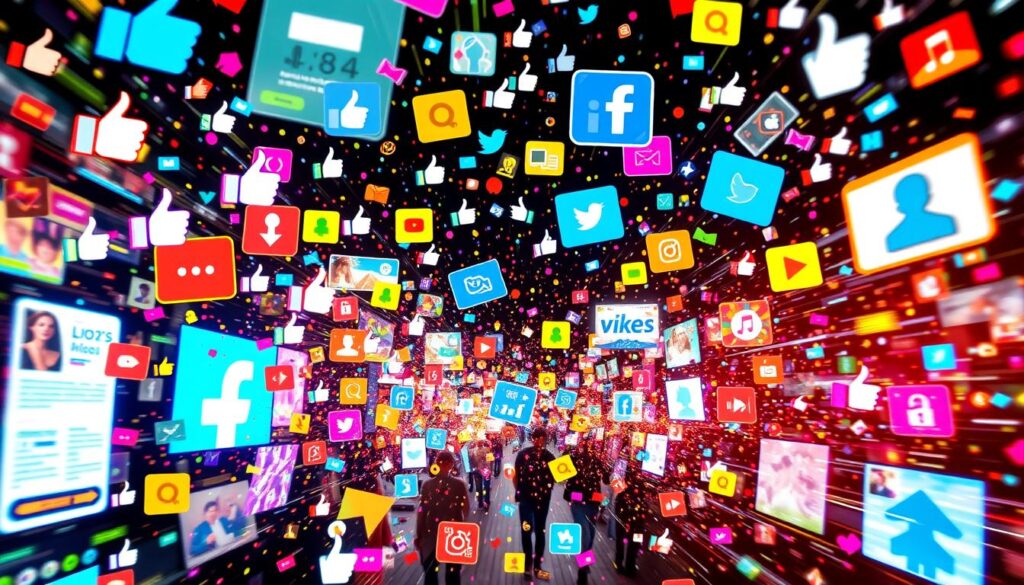I remember when I first saw a video of a cat playing piano. It quickly spread across my social media, with everyone talking about it. This made me curious about how viral content works. As a content creator, I’ve learned a lot about making content go viral and how to promote it on social media.
Creating viral content is like catching lightning in a bottle. It’s exciting and unpredictable. When it happens, it can make your brand shine online. I’ve found that the best content marketing strategies involve knowing your audience, touching their emotions, and keeping up with trends.
Did you know that up to 85% of viral social media content deeply connects with its audience? This shows how important it is to offer value and engage with your followers. It’s not just about making content; it’s about creating experiences that people want to share.
As we explore viral content, we’ll look at what makes people share, the power of visuals, and tools to spread your message. Whether you’re experienced or new to marketing, these insights will help you succeed in social media. We’ll learn how to increase your chances of creating the next big viral hit.
Key Takeaways
- Viral content often resonates emotionally with the audience
- Understanding current trends is crucial for content virality
- Visual elements significantly boost engagement potential
- Storytelling techniques can enhance content shareability
- Analyzing metrics is essential for refining content strategies
- Authenticity and transparency build trust with audiences
- Platform-specific optimization increases content visibility
Understanding Viral Content in the Digital Age
Viral marketing has changed how brands reach out to people. In today’s fast world of social media, content that spreads fast can really help a brand get noticed. I’ve seen how one post can hit millions, starting big talks and getting people involved.
Defining viral content
Viral content quickly spreads on social platforms, grabbing lots of attention. It’s like word-of-mouth marketing but much bigger. The Ice Bucket Challenge is a great example, raising ALS awareness and reaching many people.
The impact of viral content on brand awareness
When content goes viral, it can make a brand very visible. Red Bull’s Stratos campaign is a good example, drawing millions worldwide and improving their image. Viral marketing can grow a brand fast and cheap, unlike traditional ads.
How viral content spreads across platforms
Viral content spreads through social sharing, creating a chain reaction. It’s interesting that content that makes us feel strong emotions like awe or anger spreads more. Positive content does better than negative, and things like videos or images help it spread fast.
| Content Type | Virality Factor | Emotional Impact |
|---|---|---|
| Video | High | Awe, Surprise |
| Images | Medium | Joy, Anger |
| Articles | Low | Interest, Sadness |
Knowing how to make content that spreads fast is key. It helps make the most of viral marketing strategies.
The Psychology Behind Shareable Content
Creating viral content isn’t just luck. It’s based on human psychology. Emotional storytelling is key to making content that people want to share.
Content that makes us feel strong emotions gets shared more. Joy, surprise, anger, or sadness connect us all. When I create content that touches these emotions, I speak to my audience’s hearts.

Content that matches a community’s identity and values gets shared. When it reflects their beliefs or interests, people share it. This boosts the content’s reach and strengthens the sharer’s brand.
Knowing what your audience needs is crucial for creating shareable content. Educational, timely, and personal stories are often shared. They offer real value, encouraging people to share with others.
| Emotion | Impact on Shareability |
|---|---|
| Joy | High |
| Surprise | High |
| Anger | Medium |
| Sadness | Low to Medium |
Innovative ideas and fresh views are memorable and shareable. By offering new perspectives, I surprise and delight my audience. This boosts the content’s chance to go viral.
“Content that aligns with the image individuals want to portray or reflects their affiliations and identities tend to be shared to boost perceived social value.”
To make viral content, I use emotional storytelling and tactics that connect with my audience. Understanding why people share helps me create content that informs and inspires.
Key Characteristics of Viral Content
I’ve found that viral content has key traits that make it hard to resist sharing. These traits are essential for successful content marketing and storytelling.
Emotional Appeal
Content that touches our hearts spreads quickly. A University of Pennsylvania study showed that strong emotions, both good and bad, make content go viral. This is why cute animal videos and shocking news stories are everywhere.
Relevance and Timeliness
Viral content is all about being current. BuzzFeed, a leader in viral content, posts over 20 times a day. They stay on top of trends, making their content seem new and relevant.
Uniqueness and Originality
Being different is key. Scrub Daddy, a simple sponge with a smile, made over $110 million after Shark Tank. Its unique design caught everyone’s eye, showing that being original pays off.
Practical Value for the Audience
Content that solves problems spreads fast. A Facebook video by Blossom about organizing tips got 15.6 million interactions in two months. People share content that helps them or teaches them something new.
To make your content go viral, use these traits. Remember, good storytelling is about creating content that connects, informs, and excites your audience.
Knowing Your Target Audience

Understanding my target audience is crucial for creating viral content. By exploring their preferences, I can make messages that really connect. Did you know 21% of consumers follow brands on social media because their values match theirs? This fact from Sprout’s 2023 Social Index Report™ shows how vital audience engagement is.
Market research helps me find out what my audience wants and needs. I also use social listening to see what people are saying about my brand. For example, CISCO has over six million followers on LinkedIn, proving the impact of well-targeted content.
Let’s examine some key factors in audience analysis:
- Demographics (age, gender, location)
- Psychographics (values, interests, lifestyle)
- Online behavior patterns
- Preferred content types
TikTok is a great example. Women aged 18-24 make up 18% of its global audience, compared to just 8.9% on Facebook. This trend analysis helps me choose the right platform for my content.
By focusing on these points, I can make content that not only reaches my audience but also gets them to share. Remember, viral content is about starting conversations and inspiring action, not just reaching people.
Leveraging Current Trends and Pop Culture
In the fast world of social media marketing, keeping up with trends is crucial. Using pop culture in content can boost engagement and visibility.
Identifying Trending Topics
I watch social platforms closely to find hot trends. Tools like Google Trends help. Timing is everything for viral content.
Incorporating Trends into Your Strategy
After spotting a trend, I think of ways to include it in my content. This might mean making memes, joining viral challenges, or referencing popular shows.
| Trend Type | Example | Potential Strategy |
|---|---|---|
| Movie Collaboration | Barbie (2023) | Product tie-ins, themed content |
| Viral TV Show | Stranger Things | 80s-inspired campaigns, character-themed products |
| Music Trend | Olivia Rodrigo | Playlist collaborations, song-inspired content |
Balancing Trends with Brand Authenticity
While trends can increase visibility, keeping true to your brand is key. I make sure the trends I use fit my brand’s values and voice. This way, my content connects with people while staying loyal to my brand.
“Leveraging pop culture trends in marketing campaigns can help brands stay relevant and connect with their audience on a deeper level.”
By finding the right mix of trendy and authentic, brands can make content that grabs attention and builds stronger relationships with customers.
Creating Viral Content: Strategies for Success
In the world of content marketing, making viral content is the ultimate goal. I’ve found that success comes from a blend of creativity, timing, and connecting with your audience. Let’s explore some effective ways to increase your viral content’s reach.

Start by tapping into emotions. Content that makes people feel something—like joy, surprise, or outrage—is more likely to get shared. Also, make it easy to share. Add social buttons to your posts and use formats like infographics or short, catchy videos.
Visuals play a big role in viral marketing. Eye-catching graphics, stunning photos, or videos can grab attention. Remember, catchy songs or soundbites often make viral clips stand out.
- Host contests or challenges with clear rules
- Create interactive content like quizzes or polls
- Use trending hashtags to increase visibility
- Post regularly and at optimal times
Lastly, don’t be afraid to take risks. Try different types of content to see what works. Whether it’s a tutorial, a motivational post, or a meme, keep trying until you hit the mark.
“Going viral isn’t just about views; it’s about creating content that people can’t help but share.”
By using these strategies, you’ll be on your way to making viral content. This content will not only reach many people but also connect with your audience.
The Power of Visual Content in Viral Marketing
Visual content is key in viral marketing. Images and videos spread faster than text posts. Let’s see why visuals are so powerful in social media.
Types of Visual Content That Perform Well
Infographics, eye-catching graphics, and short videos lead the pack. Did you know infographics get three times more likes and shares than other content? That’s a big win for your social media efforts.

Creating Eye-Catching Graphics and Images
I aim for striking designs that catch the eye. Relevant images boost views by 94% compared to text-only content. Plus, people remember 65% of what they see in images for up to three days.
Leveraging Video Content for Virality
Video is a big player in viral marketing. It can really increase engagement. For example, 64% of shoppers are more likely to buy after watching a product video. That’s why I always include video in my visual content plans.
| Visual Content Type | Impact on Engagement | Retention Rate |
|---|---|---|
| Infographics | 3x more shares | 65% after 3 days |
| Images | 94% more views | 90% influence on purchases |
| Videos | 64% increased purchase intent | 74% of internet traffic |
Using these visual content strategies has greatly improved my viral marketing campaigns. Remember, in social media, a picture is worth a thousand shares!
Crafting Compelling Captions and Headlines

Creating catchy headlines is key to making content go viral. I’ve learned that headlines with 6-12 words work best. They’re informative but short. Words like “Unlock” or “Revolutionary” add excitement and make people curious.
Using storytelling in headlines can really boost clicks. For instance, headlines with numbers, like “10 Easy Ways to Lower Your Energy Bill,” draw more readers. They promise specific, helpful info. This fits well with content marketing strategies that offer clear benefits.
Captions are also crucial for content success. Posts with images every 75-100 words get shared twice as much as those without. This shows how important it is to match great captions with stunning images to get more engagement.
“A picture is worth a thousand words, but a great caption makes it worth sharing.”
To make your headlines and captions better:
- Use action words like “Discover” or “Transform”
- Use negative words carefully (they can increase clicks by 1.5% per word)
- Try different formats like how-to guides and lists
- Use tools like CoSchedule’s Headline Analyzer to improve your headlines
By focusing on these tips, content creators can increase their output by four times. They can also see over 1,400% more organic traffic to their blogs. Remember, great headlines and captions are the first step to your content’s success – make them impactful!
Storytelling Techniques for Viral Content
Storytelling is a key to making content go viral. Emotional stories connect deeply with people, making them more likely to share and engage. Let’s look at some ways to tell stories that grab attention on social media.
Building Emotional Connections
I use universal emotions to make stories engaging. By creating relatable characters and themes, I spark interest and empathy. For instance, Dunkin Donuts’ #DunkinMenuHack campaign on Instagram got a 3.5% engagement rate. It showed off creative customer ideas, touching on pride and community.
Incorporating Brand Ethos
Adding your brand’s values to stories builds trust. I make sure stories have a clear start, middle, and end. This way, the brand message is clear. NASA’s Mars Rover Landing live stream on Facebook is a great example. It mixed science with curiosity, getting a 1.2% engagement rate.
Creating Shareable Stories
To make stories go viral, I create ones people want to share. The AIDA model helps me do this. Chipotle’s #Boorito challenge on TikTok is a good example. It got an 8% engagement rate by encouraging users to participate and using short videos.
The secret to viral stories is knowing your audience and being true to your voice. By tracking how well your content does and adjusting, you can make stories that not only spread but also connect with people for a long time.
Encouraging User Participation and Engagement
Boosting audience engagement is crucial for creating viral content. By getting users involved, we can make our social media marketing more effective. Let’s look at some strategies to do this.
Interactive elements can spark engagement. Quizzes, contests, and challenges work well. The ALS Ice Bucket Challenge in 2014 is a great example of this.
Another strategy is to ask users to share their stories. This not only boosts engagement but also builds a community. Dove’s Real Beauty campaign is a perfect example of this.
| UGC Strategy | Benefits |
|---|---|
| Clear goals and audience targeting | Creates effective, resonating campaigns |
| Incentives and challenges | Encourages participation and authentic content |
| Leveraging social media platforms | Increases visibility and reach |
| Active audience engagement | Builds community and boosts online presence |
To make your social media marketing more effective, use clear calls-to-action. Tell your audience what to do next. By using these strategies, you’ll be on your way to creating viral content that boosts your brand’s digital presence.
Optimizing Content for Different Social Media Platforms
It’s important to tailor content for each social media platform. Each one has its own features and audience. I’ll share tips on how to make your content work best on different platforms.
Platform-Specific Content Strategies
Each social media platform attracts different types of users. Instagram and TikTok are great for visual content. LinkedIn is better for professional, industry-related posts. I adjust my content to fit each platform’s strengths.
| Platform | Content Type | Optimal Length |
|---|---|---|
| Facebook/Instagram | Videos, Stories | 15-30 seconds |
| Instagram IGTV | Longer videos | 5-10 minutes |
| YouTube | In-depth videos | 6-8 minutes |
| TikTok | Short-form videos | 15-60 seconds |
Tailoring Content Format
Video content is great for keeping users engaged. I make short, impactful videos for Facebook and Instagram. For YouTube, I create longer, more detailed videos. It’s important to consider the right aspect ratios and resolutions for each platform.
Understanding Platform Algorithms
Knowing how each platform’s algorithm works is crucial. I focus on making videos that grab attention right away. This is because most users don’t have sound on. Adding captions and subtitles is also key, as many users scroll with sound off. By tailoring content to each platform, I improve my social media promotion and content marketing strategies.
“The key to successful social media promotion lies in understanding and adapting to each platform’s unique ecosystem.”
Measuring and Analyzing Viral Content Performance
Measuring how well viral content does is key for social media marketing success. By looking at important metrics, we can make our strategies better. This helps us create content that spreads fast.
Engagement metrics show how well our content does. Likes, shares, and comments tell us how our audience reacts. Click-through rates show if our content gets people to take action. These numbers help us see what our followers like.
Staying ahead in viral content means analyzing trends. By looking at what works, we can find patterns. For example, a study found that emotional content does well. Content that shocks, inspires, or disgusts gets a lot of attention.
Data visualization is important for viral success. Campaigns with rankings or comparisons get lots of shares. A study on voice assistants sparked a big discussion in tech, showing the power of data.
To make our viral content better, we should:
- Make content fit each platform
- Post when most people are online
- Use catchy headlines
- Grow our online followers
- Work with influencers
By always checking how our content does and making changes, we can make content that really connects with our audience. This boosts brand awareness and engagement.
Leveraging Tools and Technology for Viral Content Creation
Using the right tools can really boost your content marketing strategies. AI-powered platforms are especially helpful for making viral content. They can come up with new ideas, make headlines better, and suggest personalized content.
Social media promotion gets a big help from scheduling tools. These tools let you post at the best times on different platforms. It’s like having a team working for you all day, every day!
Analytics tools are key for seeing how well your content does. They show you what your audience likes. This info helps you make your content even better and more likely to go viral.
“Understanding audience interests and creating emotionally resonant content are key strategies for increasing engagement and shareability of content.”
Let’s look at some impressive stats:
| Tool/Platform | Feature | Impact |
|---|---|---|
| BuzzSumo | Content Performance Analysis | Identifies key factors contributing to virality |
| Netflix | AI-driven Recommendations | Increased user engagement and retention |
| New York Times | AI-powered Headline Optimization | Higher reader engagement and subscription rates |
By using these tools, you’re not just making content. You’re creating experiences that people want to share. It’s about being smart and efficient in your quest for viral success.
Conclusion
Creating viral content for social media is both an art and a science. It requires creativity, strategy, and using data to make decisions. Successful content often makes people laugh, surprise them, or amaze them. This emotional connection is crucial for getting people to engage and share.
Visual content is very important in today’s fast world. Studies show that adding visuals can increase engagement by 80% compared to just text. This matches the trend of people preferring short, easy-to-consume content, which 70% of users like.
To make viral content work best, use analytics to find the best times to post. Sharing content on different platforms can increase reach by 40%. Working with influencers can boost visibility by 60%. By always improving strategies based on data and feedback, brands can make content that really connects and spreads fast online.
FAQ
What is viral content?
Viral content spreads fast on social media. It grabs attention and makes people want to share it. This can help brands reach more people quickly.
What makes content shareable and likely to go viral?
Content that makes you feel something is more likely to be shared. It should connect with you, be timely, and offer value. This way, it can spread widely.
Why is understanding the target audience crucial for creating viral content?
Knowing what your audience likes helps you make content they’ll share. Good research lets you create messages that really hit home.
How can you leverage current trends and pop culture for viral content?
Use what’s popular right now in your content. Being on trend can make your content more likely to go viral. Just make sure it still fits your brand.
What strategies can be employed to create viral content?
To make viral content, tap into emotions and make it easy to share. Use visuals, get people involved, and tell compelling stories. Good captions and headlines help too.
Why is visual content important for viral marketing?
Visuals like images and videos are more likely to spread. They catch your eye and are easy to get through. This leads to more sharing on social media.
How can storytelling techniques enhance the virality of content?
Stories that touch your heart can make you want to share. Make sure your brand’s values shine through in these stories. It builds trust and loyalty.
Why is user participation important for viral content?
Getting people involved makes your content more engaging. Quizzes and contests can encourage sharing. It makes your content feel more personal.
How can you optimize content for different social media platforms?
Each platform is different. Tailor your content to fit each one’s style. Knowing the algorithms helps you get seen by more people.
How can you measure and analyze the performance of viral content?
Use tools to track how well your content does. Look at likes, shares, and comments. This helps you make even better content in the future.
What tools and technologies can help with viral content creation?
AI and scheduling tools can make creating and sharing content easier. They help come up with ideas, post at the best times, and track how well things do.

